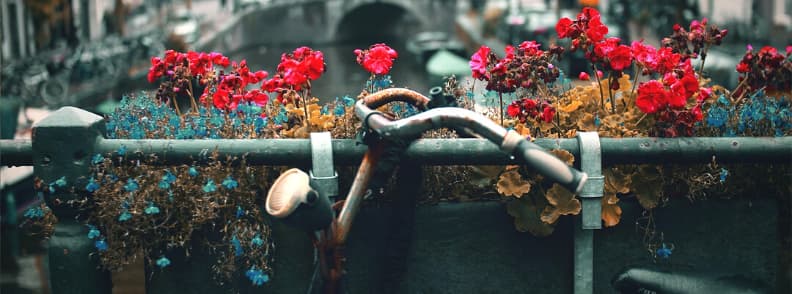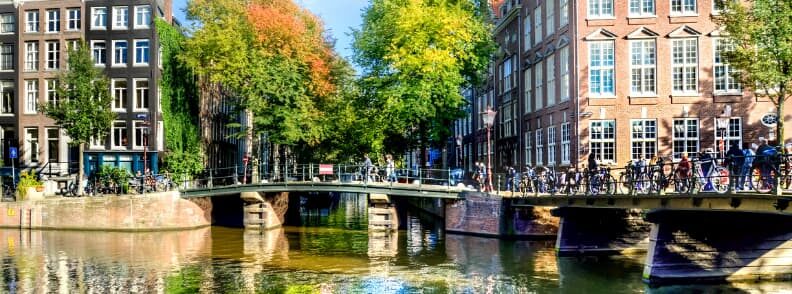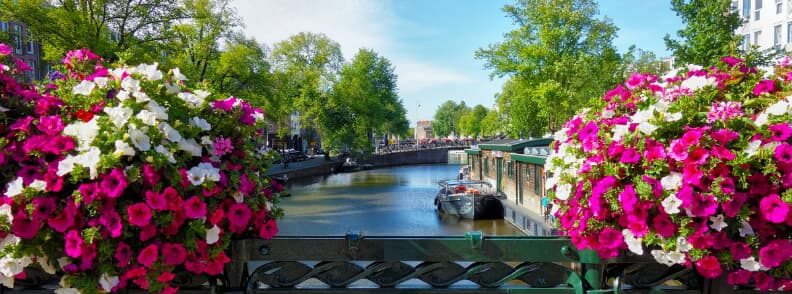With a blissful backdrop made up of windy street canals, bright-colored bicycles, and tousling tree leaves lining the Dutch cobbles, green Amsterdam’s city center looks nothing short of a Disney movie. As one of the most popular tourist destinations across Europe, over the years, this city has become popular for more than the likes of Anne Frank and their impeccable music scene.
Amongst its historical beauty, liberal culture, and world-renowned restaurants, Amsterdam has also become the capital of sustainability. As you step off your plane, train, or automobile, prepare to enter a zero-waste zone, dedicated to reducing CO2 emissions, ditching plastic, and promoting the future of thrift culture.
Green Amsterdam is known not just for its parks and green spaces, but also for its eco-friendly attitude toward transportation and daily living. It is often regarded as one of Europe’s greenest cities or as a world eco capital. Amsterdam is a really green city that is increasingly putting greater focus on the social effects, with cycling as the city’s primary mode of transportation, higher than average recycling rates, and a significant shift towards a circular economy across all industries.
It’s hard not to fall in love with this city. Read on to find out how and why green Amsterdam is taking sustainability so seriously and how you can embrace their zero-waste culture on your next post-covid trip.
Why is sustainability important?

The average EU citizen currently generates over 31 kg of plastic waste annually. As that number steadily rises amongst the average European household, plastic pollution continues to pose a threat to both landfills and aquatic environments across the planet. In fact, it was recently estimated that over 10 million tons of plastic litter our oceans every year, with some microplastics taking up to 500 years to decompose.
As our plastic footprints continue to increase thanks to high levels of plastic production in both food and fashion manufacturing, it’s time to step up our own sustainability and start making zero-waste choices.
The future truly is green if we follow the footsteps of sustainable spaces such as Amsterdam, which is making simple swaps to change the way we consume plastic and the way we travel around the city. Introducing eco-friendly alternatives into our plastic-based lifestyles and becoming more eco-conscious when it comes to being out and about is the first step towards reducing both our own and the global carbon footprint.

Green Amsterdam’s zero waste trends are changing the future of sustainability
Did you know that Amsterdam is aiming to become the first European city to be completely emission-free by 2050? In their battle to reduce Carbon Emissions, they are pushing forward with a number of new sustainable initiatives that are transforming this beautiful cityscape as we know it. From planning to replace all diesel-powered public transport with zero-emission busses, to restricting the remaining polluting vehicles from accessing the center of the city, Amsterdam is a nudge away from becoming the greenest capital in the world.
If you want to find out more, here is how green Amsterdam is currently transforming the future of sustainability and how you can get involved in the green shift during your next visit.
The home of sustainable fashion
From a vintage high street to an actual sustainable fashion museum. Green Amsterdam really knows how to rock the thrift and upcycle just about any garment for the perfect sustainable style. With everything from jumpers to accessories to be found, this city knows how to upcycle. For example, with over half of women now requiring glasses, you can now even find upcycled frames. If you’re all about thrift fashion and battling those high street giants, Amsterdam could pose as the best city for a shopping-packed weekend away.
Head to Amsterdam’s famous shopping district, ‘The Ninth’ for a vintage fest. With rows of shops presenting to be worn again garments, freshly upcycled for a new life of the sustainable runway, you’ll be spoilt for choice.
One of the most popular stores to have a nosy in is Episode. Using their platform as a vintage leader alongside high street giants, they use their voice to educate sorting companies and charities on how to know the difference between clothes that are suitable for upcycling and how others can be successfully recycled.
Another great addition to green Amsterdam’s sustainable scene is the Fashion for Good Museum, Europe’s first sustainable fashion museum, created to educate others on the damages caused by fast fashion production. Amsterdam is all about green education, so there’s no surprise that this museum is free to look around. From thrift clothes to powerful art statements, this attraction is not one to miss if you want to learn about the future of this green city.
From bicycles to boats: zero waste travel in the Netherlands
Did you know that Amsterdam is one of the best cycle-friendly cities in Europe? With over 35,000km worth of bike lanes covering most of Holland, the pedal power of this nation is the largest contributor to green Amsterdam’s sustainable city title.
In fact, in 2019, the Copenhagenize Design Company ranked Amsterdam second, only just behind Copenhagen itself, as one of the best cities in the world to get around on two wheels. As more nationals and tourists alike swap public transport for luscious cycle lanes by calming dutch waters, enjoy a scenic tour of the city’s beauty spots, all while reducing your carbon footprint.
For those of us who prefer to stay off two wheels, it’s hard not to make use of the water links in Amsterdam. With canals lining their cities’ cobbled streets and Instagram-worthy bridges, another way that the Netherlands is reducing their CO2 emissions is boat travel! With heaps of unique charm, why not try one of their famous riverboats for an all-inclusive sustainable heritage experience.
The rise of the “untourist” traveler
It’s not just the nationals that are making a difference to the future of Amsterdam, as tourists, we are making our own sustainable impact too, by becoming greener in the way that we explore beautiful cities.
Mass tourism may bring in excellent revenue for the economy, but the sustainable impact can often be major, with transport levels rising, food waste increasing, and overpopulation of small areas contributing to mass littering and destruction of popular beauty spots.
If you’re a keen traveler and are worried about your own effect on the environment, worry not. Green Amsterdam has you covered. With the introduction of the Untourist Guide, this is just one feature that will let you explore Amsterdam’s best areas with sustainability in mind. From flea markets to cookery classes, this guide aims to send you away from well-known tourism clusters, in order to even out the population, and promote more sustainable activities in green Amsterdam. In fact, you can even sign on to plant vegetables in urban allotments and go litter picking along the canal if you’re a zero-waste warrior yourself.
We are quickly heading towards a more sustainable future and green Amsterdam is just the tip of the iceberg. This well-loved city may be a popular tourist destination, but its efforts to strive towards a greener future are certainly eye-opening for the rest of Europe. It’s time to step back and take a look at our own bad habits and continue to follow in the footsteps of this amazing city.

Mirela Letailleur is a Romanian travel blogger living in the South of France. She writes on The Travel Bunny travel blog about affordable travel in Europe, creator of unique free travel guides, local travel expert. Problem solver. Wannabe coffee guru.
After learning about green Amsterdam, find more eco-travel inspiration
Top 5 must-visit green travel destinations
Kangaroo Island Australia – A visit to Paradise
Romantic vacation in Tanzania: Pole Pole luxury eco-lodge hotel

